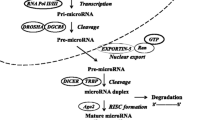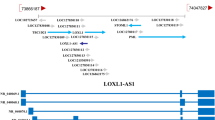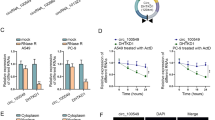Abstract
Purpose
The current study aimed to investigate the role of long intergenic noncoding 01433 (LINC01433) in the proliferation, migration and invasion of nasopharyngeal carcinoma (NPC).
Methods
Real-time quantitative PCR (RT-qPCR) was performed to determine the expressions of LINC01433 and miR-506-3p in NPC samples and cell lines. The effects of LINC01433 on cell proliferation, migration and invasion were measured by CCK-8, wound healing assay and Transwell, respectively. In addition, Pearson correlation analysis, starBase, RNA immunoprecipitation, luciferase assay, Western blot and functional experiments were conducted to detect and confirm the relationship between LINC01433 and miR-506-3p.
Results
LINC01433 level was noticeably elevated in NPC tissues and cell lines. As the expression of LINC01433 in 5-8F cells was the highest in NPC cell lines and the expression of LINC01433 in SUNE1 cells was the lowest, 5-8F and SUNE1 cells were therefore selected as the target cells for following experiments. Furthermore, miR-506-3p was predicted as the target of LINC01433, and the two were negatively correlated with each other. Interestingly, overexpression of LINC01433 promoted proliferation, migration and invasion of NPC cells, while miR-506-3p reversed such effects of LINC01433. Moreover, LINC01433 silencing had the opposite effects to LINC01433 overexpression. Furthermore, miR-506-3p overexpression inhibited the expressions of MMP2, N-cadherin, p-PI3K and p-Akt, and promoted the expressions of E-cadherin and TIMP-2, and partially reversed the role of LINC01433 in promoting cancer development.
Conclusion
The current findings reveal that LINC01433 regulates NPC cell biological progress through miR-506-3p.






Similar content being viewed by others
Availability of data and materials
The analyzed data sets generated during the study are available from the corresponding author on reasonable request.
References
Paul P, Deka H, Malakar AK, Halder B, Chakraborty S (2018) Nasopharyngeal carcinoma: understanding its molecular biology at a fine scale. Eur J Cancer Prevent 27(1):33–41. https://doi.org/10.1097/cej.0000000000000314
Chua MLK, Wee JTS, Hui EP, Chan ATC (2016) Nasopharyngeal carcinoma. Lancet (Lond, Engl) 387(10022):1012–1024. https://doi.org/10.1016/s0140-6736(15)00055-0
Renganathan A, Felley-Bosco E (2017) Long noncoding RNAs in cancer and therapeutic potential. Adv Exp Med Biol 1008:199–222. https://doi.org/10.1007/978-981-10-5203-3_7
Cai Z, Xu K, Li Y, Lv Y, Bao J, Qiao L (2017) Long noncoding RNA in liver cancer stem cells. Discov Med 24(131):87–93
Li J, Li Z, Zheng W, Li X, Wang Z, Cui Y, Jiang X (2017) LncRNA-ATB: An indispensable cancer-related long noncoding RNA. Cell Prolif 50:6. https://doi.org/10.1111/cpr.12381
Wang J, Su Z, Lu S, Fu W, Liu Z, Jiang X, Tai S (2018) LncRNA HOXA-AS2 and its molecular mechanisms in human cancer. Clin Chim Acta 485:229–233. https://doi.org/10.1016/j.cca.2018.07.004
Huang HW, Xie H, Ma X, Zhao F, Gao Y (2017) Upregulation of LncRNA PANDAR predicts poor prognosis and promotes cell proliferation in cervical cancer. Eur Rev Med Pharmacol Sci 21(20):4529–4535
Geng YJ, Xie SL, Li Q, Ma J, Wang GY (2011) Large intervening non-coding RNA HOTAIR is associated with hepatocellular carcinoma progression. J Int Med Res 39(6):2119–2128. https://doi.org/10.1177/147323001103900608
Zhang R, Xia Y, Wang Z, Zheng J, Chen Y, Li X, Wang Y, Ming H (2017) Serum long non coding RNA MALAT-1 protected by exosomes is up-regulated and promotes cell proliferation and migration in non-small cell lung cancer. Biochem Biophys Res Commun 490(2):406–414. https://doi.org/10.1016/j.bbrc.2017.06.055
He R, Hu Z, Wang Q, Luo W, Li J, Duan L, Zhu YS, Luo DX (2017) The role of long non-coding RNAs in nasopharyngeal carcinoma: as systemic review. Oncotarget 8(9):16075–16083. https://doi.org/10.18632/oncotarget.14211
Sun Q, Liu H, Li L, Zhang S, Liu K, Liu Y, Yang C (2015) Long noncoding RNA-LET, which is repressed by EZH2, inhibits cell proliferation and induces apoptosis of nasopharyngeal carcinoma cell. Med Oncol (Northwood, Lond, Engl) 32(9):226. https://doi.org/10.1007/s12032-015-0673-0
Yang QQ, Deng YF (2015) Genome-wide analysis of long non-coding RNA in primary nasopharyngeal carcinoma by microarray. Histopathology 66(7):1022–1030. https://doi.org/10.1111/his.12616
Nie Y, Liu X, Qu S, Song E, Zou H, Gong C (2013) Long non-coding RNA HOTAIR is an independent prognostic marker for nasopharyngeal carcinoma progression and survival. Cancer Sci 104(4):458–464. https://doi.org/10.1111/cas.12092
Venter JC, Adams MD, Myers EW, Li PW, Mural RJ, Sutton GG, Smith HO, Yandell M, Evans CA, Holt RA, Gocayne JD, Amanatides P, Ballew RM, Huson DH, Wortman JR, Zhang Q, Kodira CD, Zheng XH, Chen L, Skupski M, Subramanian G, Thomas PD, Zhang J, Gabor Miklos GL, Nelson C, Broder S, Clark AG, Nadeau J, McKusick VA, Zinder N, Levine AJ, Roberts RJ, Simon M, Slayman C, Hunkapiller M, Bolanos R, Delcher A, Dew I, Fasulo D, Flanigan M, Florea L, Halpern A, Hannenhalli S, Kravitz S, Levy S, Mobarry C, Reinert K, Remington K, Abu-Threideh J, Beasley E, Biddick K, Bonazzi V, Brandon R, Cargill M, Chandramouliswaran I, Charlab R, Chaturvedi K, Deng Z, Di Francesco V, Dunn P, Eilbeck K, Evangelista C, Gabrielian AE, Gan W, Ge W, Gong F, Gu Z, Guan P, Heiman TJ, Higgins ME, Ji RR, Ke Z, Ketchum KA, Lai Z, Lei Y, Li Z, Li J, Liang Y, Lin X, Lu F, Merkulov GV, Milshina N, Moore HM, Naik AK, Narayan VA, Neelam B, Nusskern D, Rusch DB, Salzberg S, Shao W, Shue B, Sun J, Wang Z, Wang A, Wang X, Wang J, Wei M, Wides R, Xiao C, Yan C, Yao A, Ye J, Zhan M, Zhang W, Zhang H, Zhao Q, Zheng L, Zhong F, Zhong W, Zhu S, Zhao S, Gilbert D, Baumhueter S, Spier G, Carter C, Cravchik A, Woodage T, Ali F, An H, Awe A, Baldwin D, Baden H, Barnstead M, Barrow I, Beeson K, Busam D, Carver A, Center A, Cheng ML, Curry L, Danaher S, Davenport L, Desilets R, Dietz S, Dodson K, Doup L, Ferriera S, Garg N, Gluecksmann A, Hart B, Haynes J, Haynes C, Heiner C, Hladun S, Hostin D, Houck J, Howland T, Ibegwam C, Johnson J, Kalush F, Kline L, Koduru S, Love A, Mann F, May D, McCawley S, McIntosh T, McMullen I, Moy M, Moy L, Murphy B, Nelson K, Pfannkoch C, Pratts E, Puri V, Qureshi H, Reardon M, Rodriguez R, Rogers YH, Romblad D, Ruhfel B, Scott R, Sitter C, Smallwood M, Stewart E, Strong R, Suh E, Thomas R, Tint NN, Tse S, Vech C, Wang G, Wetter J, Williams S, Williams M, Windsor S, Winn-Deen E, Wolfe K, Zaveri J, Zaveri K, Abril JF, Guigo R, Campbell MJ, Sjolander KV, Karlak B, Kejariwal A, Mi H, Lazareva B, Hatton T, Narechania A, Diemer K, Muruganujan A, Guo N, Sato S, Bafna V, Istrail S, Lippert R, Schwartz R, Walenz B, Yooseph S, Allen D, Basu A, Baxendale J, Blick L, Caminha M, Carnes-Stine J, Caulk P, Chiang YH, Coyne M, Dahlke C, Mays A, Dombroski M, Donnelly M, Ely D, Esparham S, Fosler C, Gire H, Glanowski S, Glasser K, Glodek A, Gorokhov M, Graham K, Gropman B, Harris M, Heil J, Henderson S, Hoover J, Jennings D, Jordan C, Jordan J, Kasha J, Kagan L, Kraft C, Levitsky A, Lewis M, Liu X, Lopez J, Ma D, Majoros W, McDaniel J, Murphy S, Newman M, Nguyen T, Nguyen N, Nodell M, Pan S, Peck J, Peterson M, Rowe W, Sanders R, Scott J, Simpson M, Smith T, Sprague A, Stockwell T, Turner R, Venter E, Wang M, Wen M, Wu D, Wu M, Xia A, Zandieh A, Zhu X (2001) The sequence of the human genome. Science 291(5507):1304–1351. https://doi.org/10.1126/science.1058040
Qian B, Wang X, Mao C, Jiang Y, Shi Y, Chen L, Liu S, Wang B, Pan S, Tao Y, Shi H (2018) Long non-coding RNA linc01433 promotes migration and invasion in non-small cell lung cancer. Thorac Cancer 9(5):589–597. https://doi.org/10.1111/1759-7714.12623
Wu M, Wu W, Ding J, Yang J (2019) LINC01433/miR-2116-3p/MYC feedback loop promotes cell proliferation, migration, and the epithelial-mesenchymal transition in breast cancer. Cancer Biotherapy Radiopharmaceut 34(6):388–397. https://doi.org/10.1089/cbr.2019.2772
Zhang A, Xu M, Mo YY (2014) Role of the lncRNA-p53 regulatory network in cancer. J Mol Cell Biol 6(3):181–191. https://doi.org/10.1093/jmcb/mju013
Ballantyne MD, McDonald RA, Baker AH (2016) lncRNA/MicroRNA interactions in the vasculature. Clin Pharmacol Ther 99(5):494–501. https://doi.org/10.1002/cpt.355
Kong YG, Cui M, Chen SM, Xu Y, Xu Y, Tao ZZ (2018) LncRNA-LINC00460 facilitates nasopharyngeal carcinoma tumorigenesis through sponging miR-149-5p to up-regulate IL6. Gene 639:77–84. https://doi.org/10.1016/j.gene.2017.10.006
Huang H, Bu YZ, Zhang XY, Liu J, Zhu LY, Fang Y (2019) LINC01433 promotes hepatocellular carcinoma progression via modulating the miR-1301/STAT3 axis. J Cell Physiol 234(5):6116–6124. https://doi.org/10.1002/jcp.27366
Rio DC, Ares M Jr, Hannon GJ (2010) Nilsen TW (2010) Purification of RNA using TRIzol (TRI reagent). Cold Spring Harbor Protocols 6:5439. https://doi.org/10.1101/pdb.prot5439
Xie L, Hu Z, Wang X, Li Z (2013) Expression of long noncoding RNA MALAT1 gene in human nasopharyngeal carcinoma cell lines and its biological significance. J Southern Med Univ 33(5):692–697
Bo H, Gong Z, Zhang W, Li X, Zeng Y, Liao Q, Chen P, Shi L, Lian Y, Jing Y, Tang K, Li Z, Zhou Y, Zhou M, Xiang B, Li X, Yang J, Xiong W, Li G, Zeng Z (2015) Upregulated long non-coding RNA AFAP1-AS1 expression is associated with progression and poor prognosis of nasopharyngeal carcinoma. Oncotarget 6(24):20404–20418. https://doi.org/10.18632/oncotarget.4057
Liang WC, Fu WM, Wong CW, Wang Y, Wang WM, Hu GX, Zhang L, Xiao LJ, Wan DC, Zhang JF, Waye MM (2015) The lncRNA H19 promotes epithelial to mesenchymal transition by functioning as miRNA sponges in colorectal cancer. Oncotarget 6(26):22513–22525. https://doi.org/10.18632/oncotarget.4154
Zhang W, Wang L, Zheng F, Zou R, Xie C, Guo Q, Hu Q, Chen J, Yang X, Yao H, Song E, Xiang Y (2015) Long noncoding RNA expression signatures of metastatic nasopharyngeal carcinoma and their prognostic value. Biomed Res Int 2015:618924. https://doi.org/10.1155/2015/618924
Zhang S, Zhong G, He W, Yu H, Huang J, Lin T (2016) lncRNA up-regulated in nonmuscle invasive bladder cancer facilitates tumor growth and acts as a negative prognostic factor of recurrence. J Urol 196(4):1270–1278. https://doi.org/10.1016/j.juro.2016.05.107
Nie GH, Li Z, Duan HF, Luo L, Hu HY, Yang WQ, Nie LP, Zhu RF, Chen XF, Zhang W (2017) lncRNA C22orf32-1 contributes to the tumorigenesis of nasopharyngeal carcinoma. Oncol Lett 13(6):4487–4492. https://doi.org/10.3892/ol.2017.6021
Ma DD, Yuan LL, Lin LQ (2017) LncRNA HOTAIR contributes to the tumorigenesis of nasopharyngeal carcinoma via up-regulating FASN. Eur Rev Med Pharmacol Sci 21(22):5143–5152. https://doi.org/10.26355/eurrev_201711_13831
Zhang C, Qian H, Liu K, Zhao W, Wang L (2019) A Feedback loop regulation of LINC01433 and YAP promotes malignant behavior in gastric cancer cells. OncoTargets Therapy 12:7949–7962. https://doi.org/10.2147/OTT.S222903
Qadir MI, Faheem A (2017) miRNA: a diagnostic and therapeutic tool for pancreatic cancer. Crit Rev Eukaryot Gene Expr 27(3):197–204. https://doi.org/10.1615/CritRevEukaryotGeneExpr.2017019494
Puik JR, Meijer LL, Le Large TY, Prado MM, Frampton AE, Kazemier G, Giovannetti E (2017) miRNA profiling for diagnosis, prognosis and stratification of cancer treatment in cholangiocarcinoma. Pharmacogenomics 18(14):1343–1358. https://doi.org/10.2217/pgs-2017-0010
Yu F, Lv M, Li D, Cai H, Ma L, Luo Q, Yuan X, Lv Z (2015) MiR-506 over-expression inhibits proliferation and metastasis of breast cancer cells. Med Sci Monitor 21:1687–1692. https://doi.org/10.12659/msm.893522
Yao J, Qin L, Miao S, Wang X, Wu X (2016) Overexpression of miR-506 suppresses proliferation and promotes apoptosis of osteosarcoma cells by targeting astrocyte elevated gene-1. Oncol Lett 12(3):1840–1848. https://doi.org/10.3892/ol.2016.4827
Luo Y, Sun R, Zhang J, Sun T, Liu X, Yang B (2015) miR-506 inhibits the proliferation and invasion by targeting IGF2BP1 in glioblastoma. Am J Transl Res 7(10):2007–2014
Erice O, Munoz-Garrido P, Vaquero J, Perugorria MJ, Fernandez-Barrena MG, Saez E, Santos-Laso A, Arbelaiz A, Jimenez-Aguero R, Fernandez-Irigoyen J, Santamaria E, Torrano V, Carracedo A, Ananthanarayanan M, Marzioni M, Prieto J, Beuers U, Oude Elferink RP, LaRusso NF, Bujanda L, Marin JJG, Banales JM (2018) MicroRNA-506 promotes primary biliary cholangitis-like features in cholangiocytes and immune activation. Hepatol (Baltim) 67(4):1420–1440. https://doi.org/10.1002/hep.29533
Gong M, Chen C, Zhao H, Sun M, Song M (2018) miR-506 suppresses cervical cancer cell proliferation both in vitro and in vivo. Neoplasma 65(3):331–338. https://doi.org/10.4149/neo_2018_170112N25
Liu G, Sun Y, Ji P, Li X, Cogdell D, Yang D, Parker Kerrigan BC, Shmulevich I, Chen K, Sood AK, Xue F, Zhang W (2014) MiR-506 suppresses proliferation and induces senescence by directly targeting the CDK4/6-FOXM1 axis in ovarian cancer. J Pathol 233(3):308–318. https://doi.org/10.1002/path.4348
Zhang Z, Ma J, Luan G, Kang L, Su Y, He Y, Luan F (2015) MiR-506 suppresses tumor proliferation and invasion by targeting FOXQ1 in nasopharyngeal carcinoma. PLoS ONE 10(4):e0122851. https://doi.org/10.1371/journal.pone.0122851
Li J, Ju J, Ni B, Wang H (2016) The emerging role of miR-506 in cancer. Oncotarget 7(38):62778–62788. https://doi.org/10.18632/oncotarget.11294
Liang TS, Zheng YJ, Wang J, Zhao JY, Yang DK, Liu ZS (2019) MicroRNA-506 inhibits tumor growth and metastasis in nasopharyngeal carcinoma through the inactivation of the Wnt/beta-catenin signaling pathway by down-regulating LHX2. J Exp Clin Cancer Res 38(1):97. https://doi.org/10.1186/s13046-019-1023-4
Feng X, Zhang C, Zhu L, Zhang L, Li H, He L, Mi Y, Wang Y, Zhu J, Bu Y (2017) DEPDC1 is required for cell cycle progression and motility in nasopharyngeal carcinoma. Oncotarget 8(38):63605–63619. https://doi.org/10.18632/oncotarget.18868
Lawicki S, Zajkowska M, Glazewska EK, Bedkowska GE, Szmitkowski M (2017) Plasma levels and diagnostic utility of VEGF, MMP-2 and TIMP-2 in the diagnostics of breast cancer patients. Biomarkers 22(2):157–164. https://doi.org/10.1080/1354750x.2016.1252955
Shrestha B, Bajracharya D, Byatnal AA, Kamath A, Radhakrishnan R (2017) May High MMP-2 and TIMP-2 expressions increase or decrease the aggressivity of oral cancer? Pathol Oncol Res 23(1):197–206. https://doi.org/10.1007/s12253-016-0149-3
Yi GZ, Feng WY, Zhou Q, Liu YW, Qi ST (2017) The impact of MMP-2 and its specific inhibitor TIMP-2 expression on the WHO grade and prognosis of gliomas in Chinese population: a meta-analysis. Mol Neurobiol 54(1):22–30. https://doi.org/10.1007/s12035-015-9539-x
Wang T, Hou J, Jian S, Luo Q, Wei J, Li Z, Wang X, Bai P, Duan B, Xing J, Cai J (2018) miR-29b negatively regulates MMP2 to impact gastric cancer development by suppress gastric cancer cell migration and tumor growth. J Cancer 9(20):3776–3786. https://doi.org/10.7150/jca.26263
Lei H, Gao Y, Xu X (2017) LncRNA TUG1 influences papillary thyroid cancer cell proliferation, migration and EMT formation through targeting miR-145. Acta Biochim Biophys Sin 49(7):588–597. https://doi.org/10.1093/abbs/gmx047
Derycke LD, Bracke ME (2004) N-cadherin in the spotlight of cell-cell adhesion, differentiation, embryogenesis, invasion and signalling. Int J Develop Biol 48(5–6):463–476. https://doi.org/10.1387/ijdb.041793ld
Blaschuk OW (2015) N-cadherin antagonists as oncology therapeutics. Philos Trans R Soc Lond B Biol Sci 370(1661):20140039. https://doi.org/10.1098/rstb.2014.0039
Petrova YI, Schecterson L, Gumbiner BM (2016) Roles for E-cadherin cell surface regulation in cancer. Mol Biol Cell 27(21):3233–3244. https://doi.org/10.1091/mbc.E16-01-0058
Zhu Y, Yan L, Zhu W, Song X, Yang G, Wang S (2019) MMP2/3 promote the growth and migration of laryngeal squamous cell carcinoma via PI3K/Akt-NF-kappaB-mediated epithelial-mesenchymal transformation. J Cell Physiol. https://doi.org/10.1002/jcp.28242
Kolude B, Adisa AO, Lawal AO, Adeyemi BF, Akinyamoju AO (2015) Stoichiometric expression of MMP-2/TIMP-2 in benign and malignant tumours of the salivary gland. Tumour Biol 36(4):2351–2357. https://doi.org/10.1007/s13277-014-2842-8
Xia P, Xu XY (2015) PI3K/Akt/mTOR signaling pathway in cancer stem cells: from basic research to clinical application. Am J Cancer Res 5(5):1602–1609
Funding
This work was supported by the Scientific Research Project of Zhejiang Educational Committee [Grant no. Y201636243].
Author information
Authors and Affiliations
Contributions
Substantial contributions to conception and design: MZ. Data acquisition, data analysis and interpretation: ZD, SH, MX. Drafting the article or critically revising it for important intellectual content: MZ. Final approval of the version to be published: All authors. Agreement to be accountable for all aspects of the work in ensuring that questions related to the accuracy or integrity of the work are appropriately investigated and resolved: All authors.
Corresponding author
Ethics declarations
Conflict of interest
The authors declare no conflicts of interest.
Additional information
Publisher's Note
Springer Nature remains neutral with regard to jurisdictional claims in published maps and institutional affiliations.
Supplementary Information
Below is the link to the electronic supplementary material.
Rights and permissions
About this article
Cite this article
Zhou, M., Dong, Z., Hu, S. et al. LINC01433 targets miR-506-3p to promote the biological progress of nasopharyngeal carcinoma cells. Eur Arch Otorhinolaryngol 278, 3363–3374 (2021). https://doi.org/10.1007/s00405-021-06607-w
Received:
Accepted:
Published:
Issue Date:
DOI: https://doi.org/10.1007/s00405-021-06607-w




